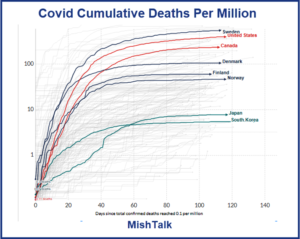 Sweden’s experiment with Covid-19 herd immunity is now widely acknowledged as a disaster. That country now has the world’s highest Covid-19 death rate (chart; click on image to enlarge); and on November 17, 2020, their prime minister ordered the entire country into lockdown (read story here).
Sweden’s experiment with Covid-19 herd immunity is now widely acknowledged as a disaster. That country now has the world’s highest Covid-19 death rate (chart; click on image to enlarge); and on November 17, 2020, their prime minister ordered the entire country into lockdown (read story here).
On top of that, you REALLY don’t want to get Covid-19 (read that story here).
Pandemics have been around for ages, the Black Plague and Spanish Flu being infamous examples, and “Even centuries before we knew about microorganisms, antibodies or vaccination, people had a pretty good idea that being infected was something to avoid at all costs,” BBC says, but, “In 2020, cracks began to appear in this previously universal thinking,” to wit:
“Early in the Covid-19 pandemic, it was reported some people were considering the – deeply risky and highly dubious – strategy of catching Covid-19 on purpose, as a way to fast-track their route back to normal life. The terms ‘immunity passport’ and ‘herd immunity’ became part of the mainstream lexicon, and low antibody counts in the population were framed as a ‘blow’ rather than a success.”
Uh, no — that didn’t work. See Sweden, U.S. red states, and other examples.
Immunological responses are a complicated topic, and I’m not a medical professional qualified to talk about them, so all I can do is regurgitate what BBC’s well-informed journalist says about it (read entire article here):
“[Blah blah blah blah.] All this means that becoming infected with Covid-19 may not have the same payoff as receiving the vaccine.”
(I hope I did that without screwing up the technical details.) He continues,
“Herd immunity is a kind of disease resistance that occurs within a population, as a result of the build-up of immunity in individuals. … Contrary to popular belief, there is no reliable threshold at which herd immunity can be reached, such as the commonly-cited 66% of people for Covid-19. Instead, the point at which it materialises depends the reproduction (R) number, which represents the number of people that the average person infects. … In reality, this means that there is unlikely to be a single, reliable threshold at which herd immunity is reached for Covid-19. The R number varies around the world, and depends on our behaviour and the level of immunity in the population. It’s also not usually evenly distributed across a population – for example, it might be higher in cities and certain demographics. …
“This is one reason relying on the population building up herd immunity naturally is … not recommended. Due to its dynamic nature, it can be hard to spot and quick to slip away. It can also be totally impractical …. Secondly, it’s possible that people who have been infected with Covid-19 once will still be able to catch it and spread it again …. herd immunity may never materialise. Thirdly, herd immunity can come at a steep price [in deaths]. Catching any pathogen is a gamble …. A wide range of longer-term health problems are now believed to be caused by Covid-19 …. If this is true, it may well be preferable to minimise the number of infections.”
Herd immunity usually happens via vaccines
“It’s not yet clear how the immunity generated by infection with Covid-19 compares to that produced by the vaccines currently in clinical trials …. However, early results … suggest that some vaccine candidates … might be more protective than natural infections. Another crucial advantage of vaccines is that they provide the opportunity to generate immunity in large numbers of people all at once. …
In short, wait for the vaccine, get it when it becomes available, and do everything you can until then to avoid exposure to Covid-19, which includes wearing a mask in public, social distancing, washing your hands, avoiding gatherings, and treating this as a deadly disease instead of a political issue (!).
Photo below: This is what herd immunity looks like; all the dead people in this cemetery are now permanently immune to Covid-19.
